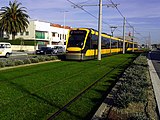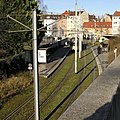Not to be confused with Grasstrack.

Green track (also grassed track or lawn track) is a type of railway track in which the track bed and surrounding area are planted with grass turf or other vegetation as ground cover. It is a popular way of making railways more visually appealing, particularly for trams and light rail, and providing additional urban green space. Aside from the visual improvement, the vegetation provides a number of positive effects, such as noise reduction, less air pollution, rainwater runoff mitigation, and reduced urban heat island effect.
History
The first green tracks were installed in 1905 along Hardenbergstraße [de] in Berlin. Due to the technical challenges they posed, many green tracks were phased out in the following decades, but beginning in the mid-1980s, green tracks have seen a resurgence.
Impact
Green tracks have a number of positive impacts on the urban environment. Green tracks reduce surface runoff by retaining an estimated 50-70% of precipitation, while remaining stormwater is released more slowly and with fewer pollutants. The absorbed water is released through evapotranspiration and provides a cooling effect on the surrounding urban micro-climate. Vegetation, commonly grass or sedum, provides an important surface for the deposit and capture of fine particulate matter. High-vegetation tracks offer sound reduction under ideal conditions of up to 3 decibels, and are subjectively perceived as quieter.
A light rail project in Sydney, Australia identified green track as requiring 81% less concrete compared to embedded track.
The cooling effect of the green surfaces, particularly in summer, lowers the temperature of the rails themselves, reducing the risk of buckling. The city of Dresden estimates that their total installed capacity of green track has a cooling effect, reducing the temperature by 10 °C (18 °F) for 8.8 billion m (2.1 cu mi) of air per year.
Green tracks, particularly planted with endemic plant species, have positive impacts on the local biodiversity, such as the use of wildflowers that serve as food sources for wild bees, and providing habitats for insects.
Types

There are several different designs for green tracks:
- Track with high vegetation, or top-of-rail (TOR): Grooved rails are placed on concrete sleepers, and the surrounding space is filled with dirt up to the grade of the top of the tracks. This technique provides the best noise abatement and a visually uniform green area, as only the track surfaces are visible. The sides of the tracks are generally protected with cavity filler blocks, to prevent direct contact between the rails and the soil, keeping the fasteners clean and preventing or slowing corrosion. The soil must be removed during track renewal operations. Soil moisture leads to corrosion in the track and fasteners, and both must typically be replaced during renewal. Because the fasteners are below the surface, it is more difficult to inspect them. The railway area is more difficult to recognize as a dangerous area, and additional protections need to be taken against stray currents. Track with high vegetation can also be crossed or driven on in exceptional circumstances.


- Track with low vegetation or foot-of-rail (FOR): Concrete sleepers are placed upon longitudinal concrete beams, and the space in between the sleepers is filled with topsoil instead of track ballast, with vegetation only reaching the base of the tracks. This has a reduced sound dampening effect, and the uniform green area is visually interrupted. However, inspection and maintenance of the rails is easier and the fasteners corrode much more slowly, as they are not constantly exposed to moisture from the soil. Switches and sensors can be mounted on the tracks, and there is better control over residual electrical current flowing into the ground. This design also allows for normal flat-bottomed rails, which are typically cheaper and easier to maintain than grooved tramway track.
- Track with mixed-level vegetation: This solution incorporates low vegetation between the rails and high vegetation outside. This allows for easier inspection of the rails, but creates a visible trough in the green surface area, where dead leaves and debris can collect.
The ground cover requires a stable track bed construction, where the track geometry will not shift after construction. This is commonly accomplished with ballastless track. The addition of soil to track ballast would reduce the friction between the individual ballast stones and make it easier for the track to shift out of place, while making adjustments and corrections more difficult. At the same time, extensions and changes are more involved than with conventional track ballast.
The soil surrounding the tracks is planted with grass or other suitable ground cover plant. In comparison, grass tends to require higher maintenance, such as mowing and irrigation, and a soil layer of at least 15 centimetres (6 in). In particular, shade- and drought-tolerant species are chosen depending on local conditions; sedum is a common choice, as it requires a substrate of only 4–8 centimetres (1.6–3.1 in). The space between the tracks can also be filled with grass pavers instead of soil. The city of Braunschweig, Germany, together with the Julius Kühn-Institut, developed a mixture of endemic grasses and wildflowers suitable for green tracks that will also provide a habitat for wild bees.
Prevalence
Green tracks are particularly common in Central Europe; in 2015, Germany had a total of 565 km (351 mi) of green track. In France, the government prescribes the use of green track wherever practicable for tramway construction.
Gallery
-
 Parramatta Light Rail Green Track.
Parramatta Light Rail Green Track.
-
 Porto Metro outside the city center
Porto Metro outside the city center
-
 Example of green tracks in Toulouse.
Example of green tracks in Toulouse.
-
 An outbound T1 train approaches the "Arènes romaines" stop in Toulouse.
An outbound T1 train approaches the "Arènes romaines" stop in Toulouse.
-
An Alstom Citadis 302 in Dijon, France
-
 High-vegation tram tracks in Freiburg, Germany
High-vegation tram tracks in Freiburg, Germany
-
 Grooved tram tracks in grass
Grooved tram tracks in grass
-
 Sedum used as ground cover in Zwickau, Germany
Sedum used as ground cover in Zwickau, Germany
-
 The Alicante Tram, combining high-vegetation with flat-bottomed rails.
The Alicante Tram, combining high-vegetation with flat-bottomed rails.
-
 The rails are covered while the track bed is being filled (Strasbourg tramway)
The rails are covered while the track bed is being filled (Strasbourg tramway)
-
 Streetcar in Seattle, 1918
Streetcar in Seattle, 1918
-
 Trams in Belgrade
Trams in Belgrade
-
 A green track tramline in Luxembourg
A green track tramline in Luxembourg
See also
- Conservation development
- Environmental design
- Environmental planning
- Green infrastructure
- Sustainable urbanism
- Urban green space
- Urban nature
- Water-sensitive urban design
References
- ^ "Rasengleis" [Grassed track]. Dresdner Verkehrsbetriebe (in German). Retrieved 22 February 2023.
- ^ Pfautsch, Sebastian; Howe, Vanessa (2018). Green Track for Parramatta Light Rail: A Review (PDF) (Report). Western Sydney University. doi:10.26183/5c05fc021efb3. Retrieved 23 February 2023.
- ^ Kappis, Christel; Schreiter, Hendrikje (2016). Handbook Track Greening (PDF). Eurail Press. ISBN 9783962450373. Retrieved 8 February 2023.
- Krüger, Friedrich; et al. (2006). Schall- und Erschütterungsschutz im Schienenverkehr: Grundlagen der Schall- und Schwingungstechnik; praxisorientierte Anwendung von Schall- und Erschütterungsschutzmaßnahmen; mit 99 Tabellen [Sound and vibration protection in rail transport: fundamentals of sound and vibration technology; practical application of sound and vibration protection measures; with 99 tables] (in German) (2nd ed.). Expert Verlag. pp. 267, 372. ISBN 9783816924944. Retrieved 23 February 2023.
- "Straßenbahnen fahren auch auf 'lebendigen Gleisen'" [Trams Also Travel on 'Living Rails']. Bremer Straßenbahn AG (in German). 25 October 2021. Retrieved 8 February 2023.
- ^ Schreiter, Hendrikje (24 June 2010). "Green Tram Tracks: The Advantages of Implementing Vegetation Systems in Tram Tracks" (PDF). Institute for Agricultural and Urban Projects at the Humboldt-University, Berlin. Retrieved 22 February 2023 – via National Association of City Transportation Officials.
- ^ Haworth, Chris (3 July 2019). "Can grass tracks transform Britain's train and tram routes?". Rail Technology Magazine. Retrieved 22 February 2023.
- ^ Horgan, Rob (9 February 2022). "Longest stretch of 'green track' in Australia laid for £1bn light railway". New Civil Engineer. Retrieved 22 February 2023.
- Altrock, Uwe; Kunze, Ronald; Schmitt, Gisela; Schubert, Dirk (2011). Jahrbuch Stadterneuerung 2011: Schwerpunkt "Stadterneuerung und Festivalisierung" [Yearbook Urban Renewal 2011: Focus on "Urban Renewal and Festivalization] (in German). Universitätsverlag der TU Berlin. ISBN 9783798323391. Retrieved 23 February 2023.
Die Gestaltung von Rasengleisen ist dabei keineswegs ein neues Gestaltungselement der Straßenbahnplanung. So wurde 1905 das erste Rasengleis der Welt in der Hardenbergstraße in Berlin eingerichtet.
- ^ "Grünes Gleis – Stand und Überblick: Ein Beitrag des Grüngleisnetzwerks" [Green track - status and overview: A contribution of the Green Track Network] (PDF). ETR – Eisenbahntechnische Rundschau (in German). Eurailpress, DVV Media Group. June 2015. Archived from the original (PDF) on 20 May 2023. Retrieved 23 February 2023.
- ^ Wirkung und Funktion Grüner Gleise [Effect and Function of Green Tracks] (PDF) (Report) (in German). Grüngleis Netzwerk. n.d. Retrieved 23 February 2023.
- Fuerst, P. (1999). "The real sound emission of Rasengleis". The Journal of the Acoustical Society of America. 105 (2): 948. Bibcode:1999ASAJ..105..948F. doi:10.1121/1.425739. Retrieved 23 February 2023.
- "Parramatta Light Rail lays first green track". nsw.gov.au (Press release). 7 February 2022. Retrieved 23 February 2023.
- "Das Bürgergutachten zur Straßenbahn-Linie 5" [The Citizens' Assessment of Streetcar Line 5] (PDF). Pro-Bus-Heepen (in German). p. 59. Retrieved 23 February 2023.
- "Für Wildbienen: Blühstreifen statt Straßenbahnschotter" [For wild bees: Flowering strips instead of tramway ballast]. RTL (in German). 6 February 2023. Retrieved 23 February 2023.
- Stachura, Jörn (18 May 2021). "Forscher entwickeln neue Braunschweiger Wildblumen-Mischung" [Researchers Develop New Braunschweig Wildflower-Mix]. Braunschweiger Zeitung. Retrieved 23 February 2023.